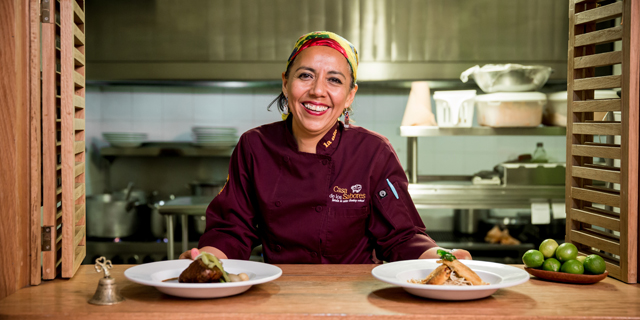Born and raised in a culinary environment and inspired by her grandmother’s cuisine, chef Pilar Cabrera is the quintessential Oaxacan woman, dishing out authentic cuisine at La Olla in Oaxaca, Mexico and leading cooking classes at Casa de los Sabores. With a background in food science, Cabrera’s passion for the smell, taste, color, and texture of ingredients led her to pursue a career in sensory research and development for Herdez –McCormick in Mexico City. But it was her roots and yearning for local ingredients that brought her back to her home town to open what is now one of the best restaurants in Oaxaca. Her philosophy and cuisine is characterized by establishing a balance between her cooking and the environment, working alongside local campesinos, supporting the local economy and serving organic products whenever available.
Here, Cabrera shares her views on Oaxacan food, past, present, and future.
TLK: What are your thoughts and feelings about Neo-Oaxacan food?
Mexican food is definitely changing. For Oaxaca, its been very beneficial because there has been a lot of promotion about this part of the world that nobody knew about and now everybody wants to visit. Everybody wants to taste our food and as a promotion effect it has been perfect. That being said, it’s difficut to recreate the flavors of Oaxaca. We use local ingredients and capturing that flavor elsewhere, well…
TLK: Why do you suppose Oaxacan food has made more inroads in the US than in far-flung parts of Mexico like Sonora or Nuevo León?
It has something to do with all the people that have migrated from Mexico to the United States, for example, Poblanos. During my most recent trip, I met a young couple from Puebla who migrated to Houston several years ago and now own a restaurant. When I entered their kitchen I was surprised with their food because I asked for Flor de Calabaza and there it was, perfectly packaged in little boxes. They told me they had maíz (corn), not only blanco but all colors and varieties, huitlacoche, and even chicatanas that had just arrived. They cook food from Puebla, and cater to a community of Poblanos in the area. So I think it’s the same with Oaxacan food and the people who have migrated years ago.
TLK: What Oaxacan ingredients would you export to the world if you could?
Definitely chiles. Chilhuacles of all colors (black, red and yellow) and Oaxacan pasilla. Chapulines and gusanos, of course, and maíz (corn).
TLK: What do you think of the about-to-explode market for artisanal mezcal? Are you concerned that other mezcales (duranguense, morelense, chiapaneco, etc.) are going to muddy the waters for Oaxacan mezcal?
I’ve tried many mezcals and just like the moles, Oaxaca’s will always be special. Something that concerns me is the overexploitation of the agave and that mezcal might lose its authenticity by becoming industrial, like tequila. The day mezcal is industrialized, it will no longer be mezcal. It will lose all of its essence. Every person in the mezcal industry has to take care of what we have. We must preserve the essence of what we are serving because if not we will end up serving Tex-Oax food.


![Making Mealtime Matter with La Familia: Easy Sofrito [Video]](https://thelatinkitchen.com/wp-content/uploads/2015/10/sofrito-shutterstock__0-500x383.jpg)
![Easy Latin Smoothies: Goji Berry Smoothie [Video]](https://thelatinkitchen.com/wp-content/uploads/2015/12/goji_berry-shutterstock_-500x383.jpg)
















![Fun and Fast Recipes: Fiesta Cabbage Salad [Video]](https://thelatinkitchen.com/wp-content/uploads/2015/11/fiesta_cabbage_slaw-shutterstock_-500x383.jpg)









